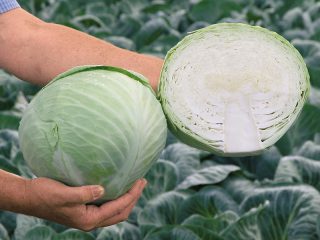Content
Crispy cabbage is always held in high esteem by Russians in fresh, salted, and pickled form. From this vegetable you can prepare not only first and second courses, salads, but also pies and pies. Unfortunately, not all gardeners grow cabbage. The reason is not the complexity of agricultural technology, but the fact that cabbage is attacked by pests and diseases during growth.
Novice gardeners often wonder why cabbage can turn yellow lower leaves. And not only after planting on the ridges, but also at the seedling stage. There are many reasons that lead to yellowing of the lower leaves; we will try to talk about them and control measures.
Causes of yellowing leaves
Problems associated with agricultural technology
If you notice yellow leaves on cabbage, you should not immediately resort to pesticides to kill pests or diseases.
More often the lower leaves turn yellow and then fall off due to nutritional imbalance:
- The lower leaves will turn yellow if there is not enough nitrogen in the soil. And cabbage needs it to grow green mass. Timely fertilizing with urea or other nitrogen-containing fertilizers helps the plant recover and grow heads.
- Yellowing of cabbage leaves on the bottom may be due to a lack of phosphorus.In this case, problems arise not only with the leaf plate, but also the growth of cabbage slows down. The solution to the problem is the use of nitrogen-phosphorus fertilizers.
- In cauliflower, like all its relatives, the leaves below change color if there is not enough magnesium in the soil. The deficiency of this microelement can be determined by pale leaf blades, on which the veins remain green for a long time. If the soil is acidic, then fertilizing with mineral fertilizer will not give the desired result. The problem needs to be solved before planting cabbage: lime the soil.
Lack of care
Almost all types of cabbage, and especially cauliflower, prefer open sunny places. If there is not enough light, the lower leaves may turn yellow. This is a kind of signal that cannot be ignored.
Our readers often write that cabbage grows in the sun, is well fed, but the leaves still turn yellow and fall off.
What could be the reason:
- Sharp changes in daily temperatures, especially in early spring, do not allow the plant to develop harmoniously.
- Untimely loosening of the soil leads to oxygen starvation; plants absorb microelements and nutrients worse.
- Lack of moisture in the soil or uneven watering.
Even a novice gardener will understand what to do. Strictly follow the agrotechnical rules associated with caring for cabbage: watering, fertilizing, loosening.
Pests
Pest activity can lead to yellowing of leaves. Cabbage leaves are liked by aphids, cutworm caterpillars, cabbage butterflies, cabbage fly larvae and other lovers of succulent leaves. If the lower leaves have changed color, look under the leaf blade.
If you see pests, take action immediately. Sprinkle wood ash directly over the plants. You can also add red hot pepper around the stem. Spraying with valerian helps against caterpillars.
Infection is more difficult to fight
The problems listed above are nothing compared to infectious wilting and yellowing of leaves, because you can quickly get cabbage in order. As for infections and diseases, in some cases you will even have to part with the plants.
- Fusarium leaf wilt is a fungal disease. The disease develops at the seedling stage. The leaves lose their elasticity, turn yellow, wither and eventually fall off. You can make sure that it is fusarium by cutting the stem - brown dots are noticeable on it. What to do with cabbage, is it possible to save it? Plants on which signs of a fungal disease are found are destroyed, and the soil is treated with copper sulfate (5 grams of the substance per ten liters of clean water).
- Downy mildew also begins on seedlings. If powdery mildew is not dealt with in a timely manner, the plant may die because the lower leaves first turn yellow and fall off. This is an infection, so it is not always possible to protect neighboring plants. You can avoid the disease if you disinfect the seeds and soil with the same solution of copper sulfate. The procedure for treating the plant and soil is repeated after planting the seedlings outside. To prevent the “medicine” from immediately dripping from the leaves, liquid soap is added to the solution.
- The third infectious disease is also fungal. This is clubroot. The disease can be recognized by growths and thickenings that appear on the roots. They “steal” nutrients, and no food gets to the leaves and head of cabbage. Nothing can be done to save the plant.Moreover, the affected plant must be urgently removed and the soil disinfected. In the beds where cabbage clubroot is found, serious soil treatment is needed, first with ash, and in the fall after harvesting with copper sulfate.
Cabbage diseases:
Conclusion
As you can see, cabbage leaves can turn yellow and fall off for various reasons. Such summer “leaf fall” can be prevented if one does not forget about prevention, starting from the seed stage. Timely treatment with drugs such as Gamair or Alirin will help prevent the development of fungal diseases. You can also use the products during the period of tying forks.













